Myle Ott
PyTorch FSDP: Experiences on Scaling Fully Sharded Data Parallel
Apr 21, 2023Abstract:It is widely acknowledged that large models have the potential to deliver superior performance across a broad range of domains. Despite the remarkable progress made in the field of machine learning systems research, which has enabled the development and exploration of large models, such abilities remain confined to a small group of advanced users and industry leaders, resulting in an implicit technical barrier for the wider community to access and leverage these technologies. In this paper, we introduce PyTorch Fully Sharded Data Parallel (FSDP) as an industry-grade solution for large model training. FSDP has been closely co-designed with several key PyTorch core components including Tensor implementation, dispatcher system, and CUDA memory caching allocator, to provide non-intrusive user experiences and high training efficiency. Additionally, FSDP natively incorporates a range of techniques and settings to optimize resource utilization across a variety of hardware configurations. The experimental results demonstrate that FSDP is capable of achieving comparable performance to Distributed Data Parallel while providing support for significantly larger models with near-linear scalability in terms of TFLOPS.
OPT: Open Pre-trained Transformer Language Models
May 05, 2022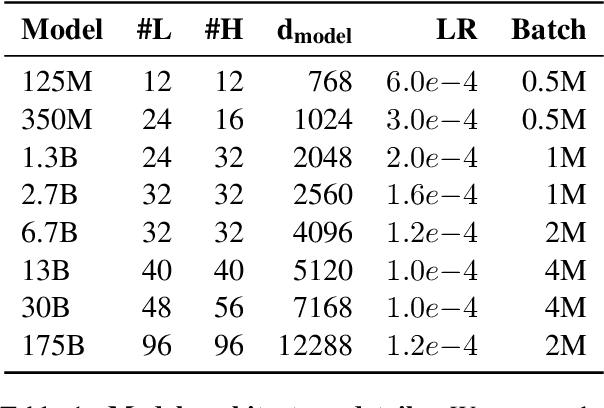
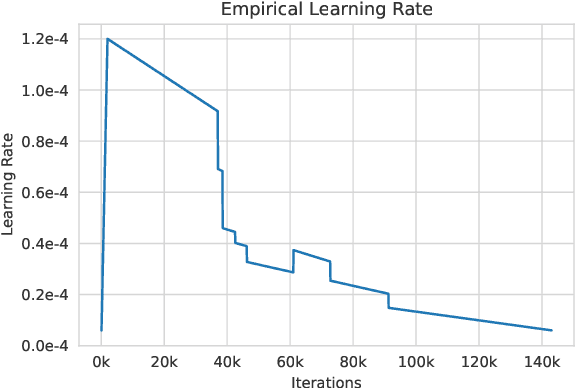
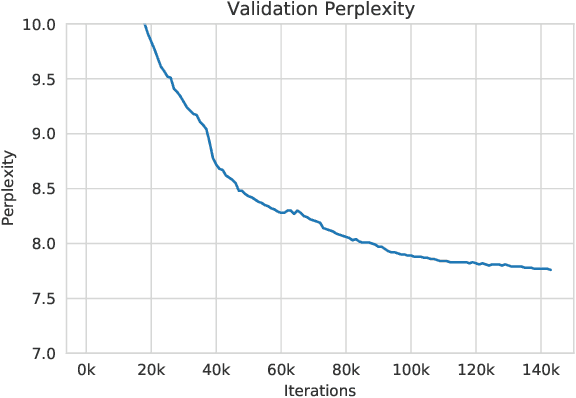

Abstract:Large language models, which are often trained for hundreds of thousands of compute days, have shown remarkable capabilities for zero- and few-shot learning. Given their computational cost, these models are difficult to replicate without significant capital. For the few that are available through APIs, no access is granted to the full model weights, making them difficult to study. We present Open Pre-trained Transformers (OPT), a suite of decoder-only pre-trained transformers ranging from 125M to 175B parameters, which we aim to fully and responsibly share with interested researchers. We show that OPT-175B is comparable to GPT-3, while requiring only 1/7th the carbon footprint to develop. We are also releasing our logbook detailing the infrastructure challenges we faced, along with code for experimenting with all of the released models.
Efficient Language Modeling with Sparse all-MLP
Mar 16, 2022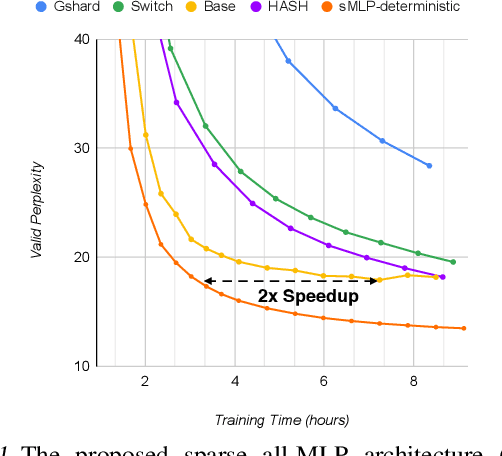
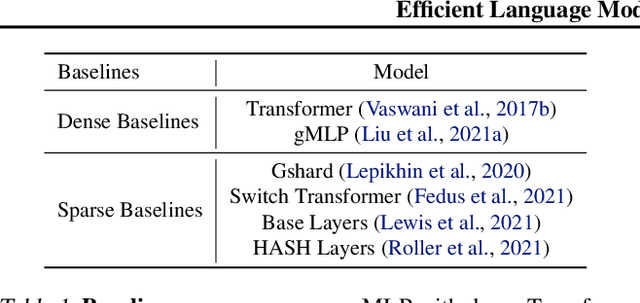
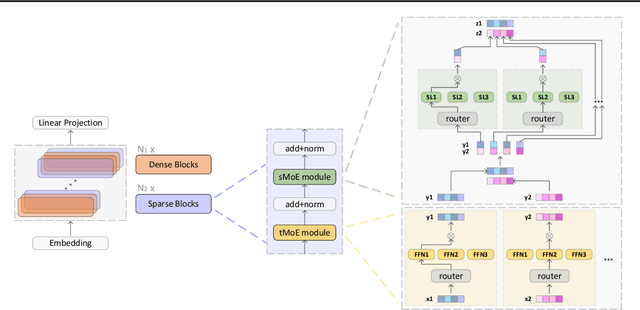

Abstract:All-MLP architectures have attracted increasing interest as an alternative to attention-based models. In NLP, recent work like gMLP shows that all-MLPs can match Transformers in language modeling, but still lag behind in downstream tasks. In this work, we analyze the limitations of MLPs in expressiveness, and propose sparsely activated MLPs with mixture-of-experts (MoEs) in both feature and input (token) dimensions. Such sparse all-MLPs significantly increase model capacity and expressiveness while keeping the compute constant. We address critical challenges in incorporating conditional computation with two routing strategies. The proposed sparse all-MLP improves language modeling perplexity and obtains up to 2$\times$ improvement in training efficiency compared to both Transformer-based MoEs (GShard, Switch Transformer, Base Layers and HASH Layers) as well as dense Transformers and all-MLPs. Finally, we evaluate its zero-shot in-context learning performance on six downstream tasks, and find that it surpasses Transformer-based MoEs and dense Transformers.
Efficient Large Scale Language Modeling with Mixtures of Experts
Dec 20, 2021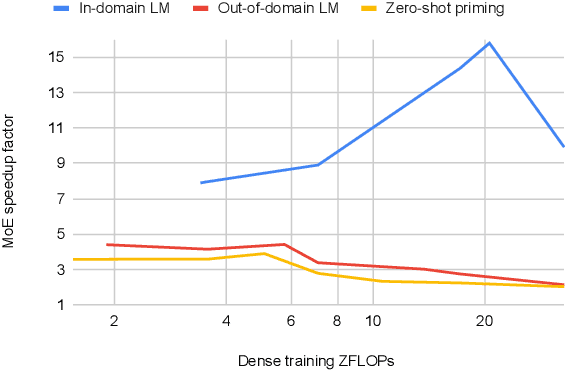

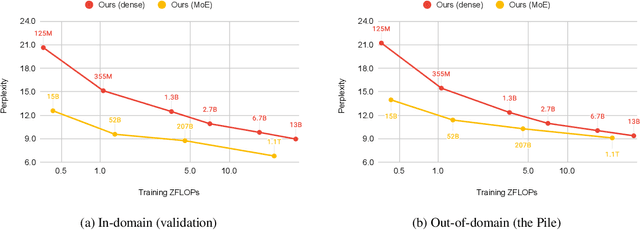
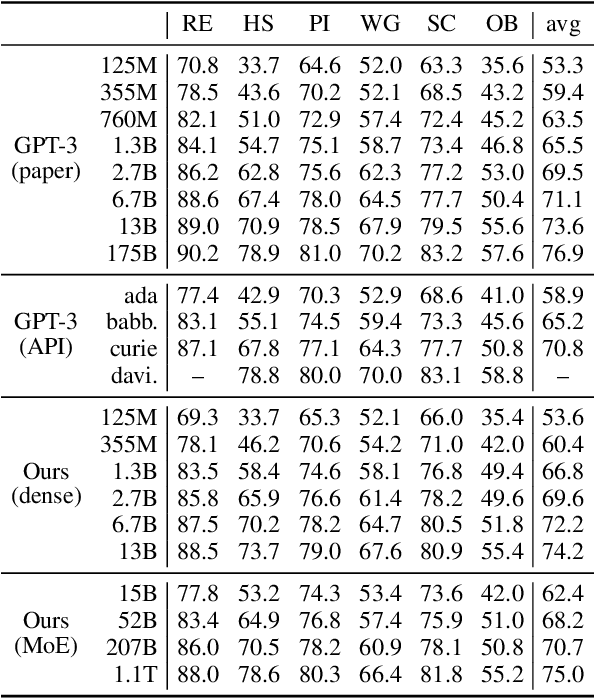
Abstract:Mixture of Experts layers (MoEs) enable efficient scaling of language models through conditional computation. This paper presents a detailed empirical study of how autoregressive MoE language models scale in comparison with dense models in a wide range of settings: in- and out-of-domain language modeling, zero- and few-shot priming, and full fine-tuning. With the exception of fine-tuning, we find MoEs to be substantially more compute efficient. At more modest training budgets, MoEs can match the performance of dense models using $\sim$4 times less compute. This gap narrows at scale, but our largest MoE model (1.1T parameters) consistently outperforms a compute-equivalent dense model (6.7B parameters). Overall, this performance gap varies greatly across tasks and domains, suggesting that MoE and dense models generalize differently in ways that are worthy of future study. We make our code and models publicly available for research use.
Few-shot Learning with Multilingual Language Models
Dec 20, 2021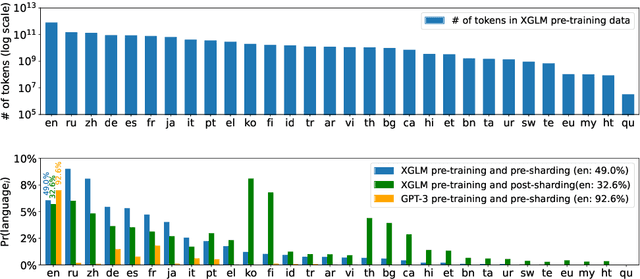
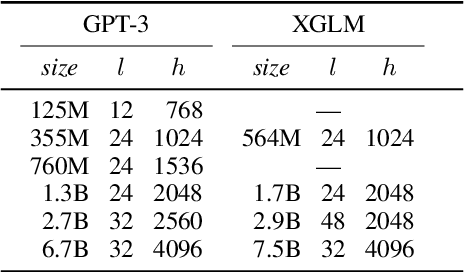
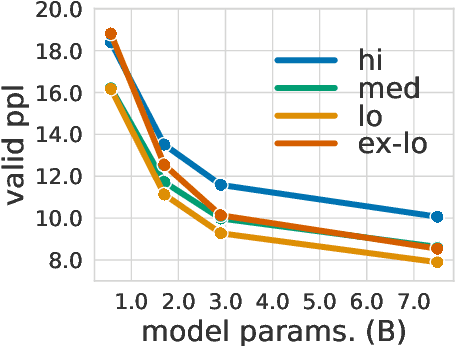

Abstract:Large-scale autoregressive language models such as GPT-3 are few-shot learners that can perform a wide range of language tasks without fine-tuning. While these models are known to be able to jointly represent many different languages, their training data is dominated by English, potentially limiting their cross-lingual generalization. In this work, we train multilingual autoregressive language models on a balanced corpus covering a diverse set of languages, and study their few- and zero-shot learning capabilities in a wide range of tasks. Our largest model with 7.5 billion parameters sets new state of the art in few-shot learning in more than 20 representative languages, outperforming GPT-3 of comparable size in multilingual commonsense reasoning (with +7.4% absolute accuracy improvement in 0-shot settings and +9.4% in 4-shot settings) and natural language inference (+5.4% in each of 0-shot and 4-shot settings). On the FLORES-101 machine translation benchmark, our model outperforms GPT-3 on 171 out of 182 translation directions with 32 training examples, while surpassing the official supervised baseline in 45 directions. We present a detailed analysis of where the model succeeds and fails, showing in particular that it enables cross-lingual in-context learning on some tasks, while there is still room for improvement on surface form robustness and adaptation to tasks that do not have a natural cloze form. Finally, we evaluate our models in social value tasks such as hate speech detection in five languages and find it has limitations similar to comparable sized GPT-3 models.
NormFormer: Improved Transformer Pretraining with Extra Normalization
Nov 01, 2021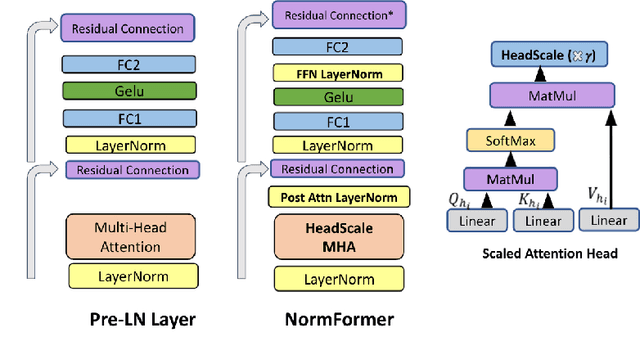

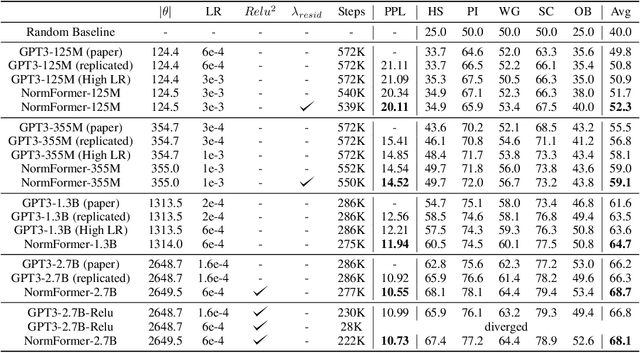
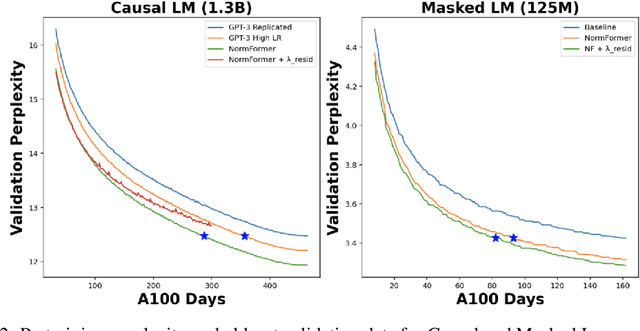
Abstract:During pretraining, the Pre-LayerNorm transformer suffers from a gradient magnitude mismatch: gradients at early layers are much larger than at later layers. These issues can be alleviated by our proposed NormFormer architecture, which adds three normalization operations to each layer: a Layer Norm after self attention, head-wise scaling of self-attention outputs, and a Layer Norm after the first fully connected layer. The extra operations incur negligible compute cost (+0.4% parameter increase), but improve pretraining perplexity and downstream task performance for both causal and masked language models ranging from 125 Million to 2.7 Billion parameters. For example, adding NormFormer on top of our strongest 1.3B parameter baseline can reach equal perplexity 24% faster, or converge 0.27 perplexity better in the same compute budget. This model reaches GPT3-Large (1.3B) zero shot performance 60% faster. For masked language modeling, NormFormer improves fine-tuned GLUE performance by 1.9% on average. Code to train NormFormer models is available in fairseq https://github.com/pytorch/fairseq/tree/main/examples/normformer .
Sustainable AI: Environmental Implications, Challenges and Opportunities
Oct 30, 2021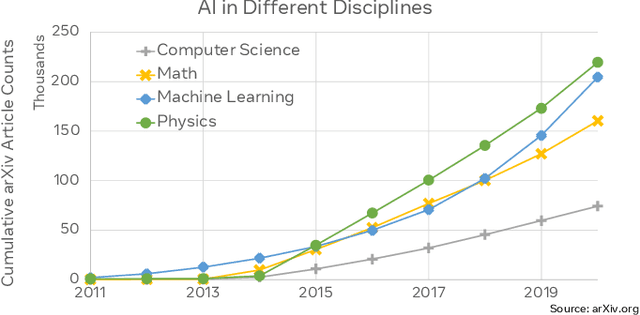

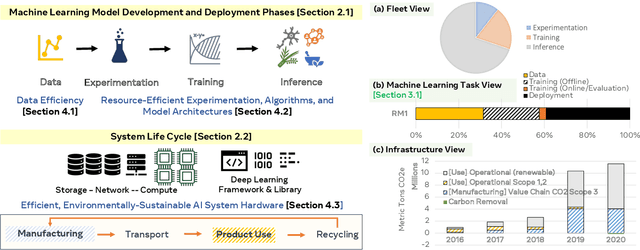
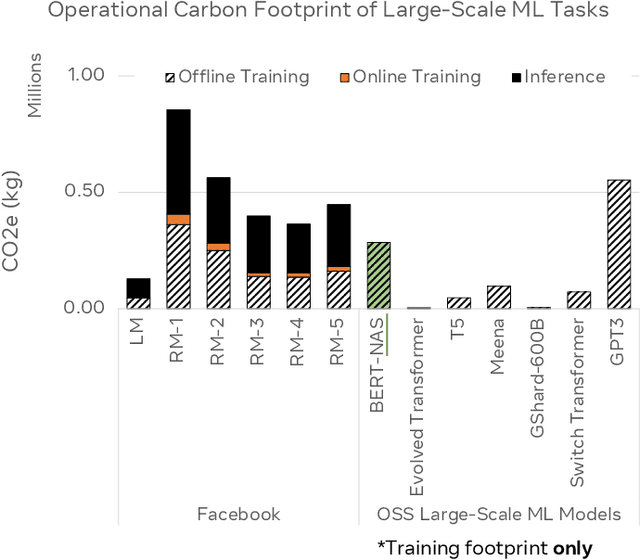
Abstract:This paper explores the environmental impact of the super-linear growth trends for AI from a holistic perspective, spanning Data, Algorithms, and System Hardware. We characterize the carbon footprint of AI computing by examining the model development cycle across industry-scale machine learning use cases and, at the same time, considering the life cycle of system hardware. Taking a step further, we capture the operational and manufacturing carbon footprint of AI computing and present an end-to-end analysis for what and how hardware-software design and at-scale optimization can help reduce the overall carbon footprint of AI. Based on the industry experience and lessons learned, we share the key challenges and chart out important development directions across the many dimensions of AI. We hope the key messages and insights presented in this paper can inspire the community to advance the field of AI in an environmentally-responsible manner.
On Anytime Learning at Macroscale
Jun 17, 2021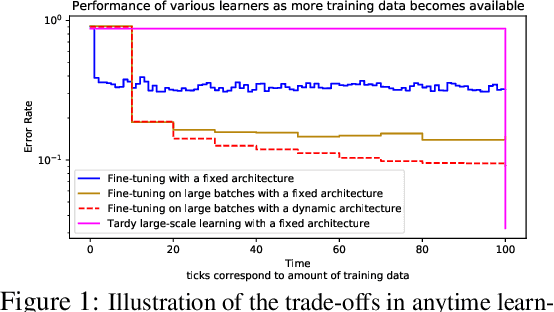
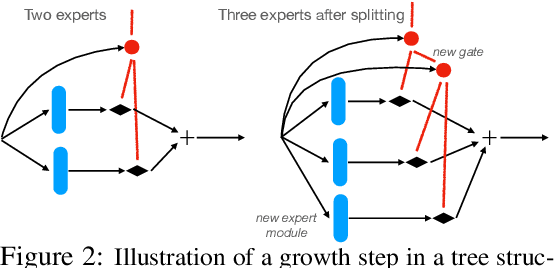
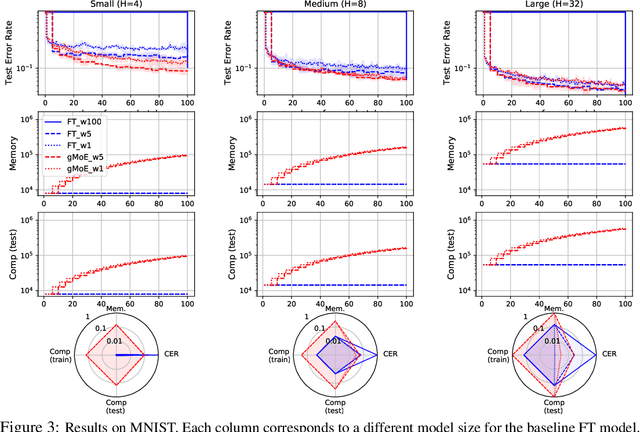
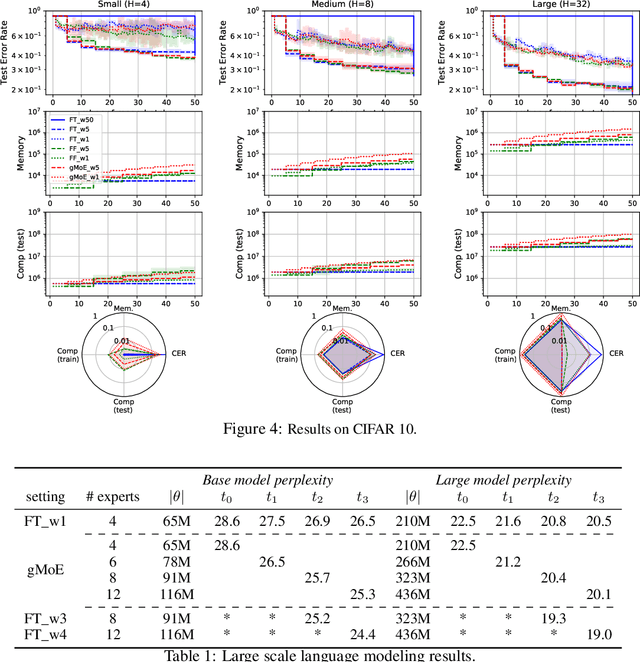
Abstract:Classical machine learning frameworks assume access to a possibly large dataset in order to train a predictive model. In many practical applications however, data does not arrive all at once, but in batches over time. This creates a natural trade-off between accuracy of a model and time to obtain such a model. A greedy predictor could produce non-trivial predictions by immediately training on batches as soon as these become available but, it may also make sub-optimal use of future data. On the other hand, a tardy predictor could wait for a long time to aggregate several batches into a larger dataset, but ultimately deliver a much better performance. In this work, we consider such a streaming learning setting, which we dub {\em anytime learning at macroscale} (ALMA). It is an instance of anytime learning applied not at the level of a single chunk of data, but at the level of the entire sequence of large batches. We first formalize this learning setting, we then introduce metrics to assess how well learners perform on the given task for a given memory and compute budget, and finally we test several baseline approaches on standard benchmarks repurposed for anytime learning at macroscale. The general finding is that bigger models always generalize better. In particular, it is important to grow model capacity over time if the initial model is relatively small. Moreover, updating the model at an intermediate rate strikes the best trade off between accuracy and time to obtain a useful predictor.
Larger-Scale Transformers for Multilingual Masked Language Modeling
May 02, 2021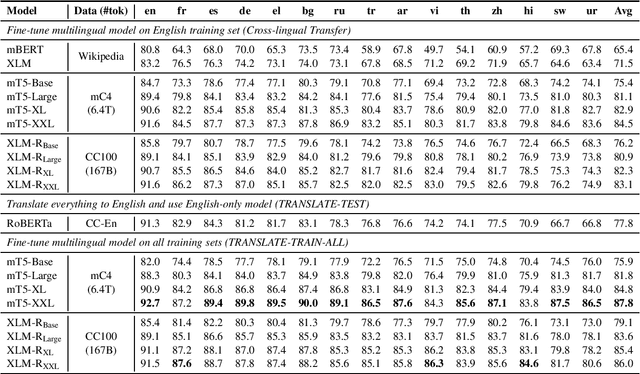



Abstract:Recent work has demonstrated the effectiveness of cross-lingual language model pretraining for cross-lingual understanding. In this study, we present the results of two larger multilingual masked language models, with 3.5B and 10.7B parameters. Our two new models dubbed XLM-R XL and XLM-R XXL outperform XLM-R by 1.8% and 2.4% average accuracy on XNLI. Our model also outperforms the RoBERTa-Large model on several English tasks of the GLUE benchmark by 0.3% on average while handling 99 more languages. This suggests pretrained models with larger capacity may obtain both strong performance on high-resource languages while greatly improving low-resource languages. We make our code and models publicly available.
Few-shot Sequence Learning with Transformers
Dec 17, 2020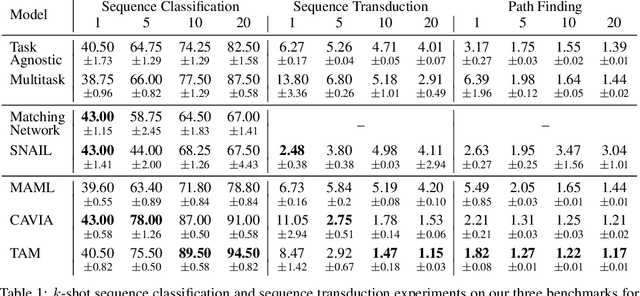
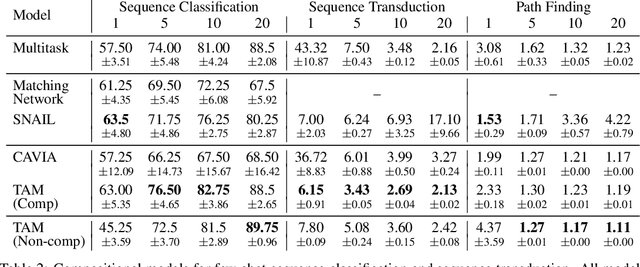
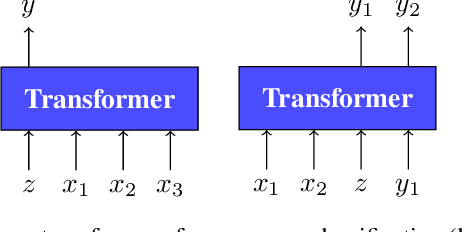

Abstract:Few-shot algorithms aim at learning new tasks provided only a handful of training examples. In this work we investigate few-shot learning in the setting where the data points are sequences of tokens and propose an efficient learning algorithm based on Transformers. In the simplest setting, we append a token to an input sequence which represents the particular task to be undertaken, and show that the embedding of this token can be optimized on the fly given few labeled examples. Our approach does not require complicated changes to the model architecture such as adapter layers nor computing second order derivatives as is currently popular in the meta-learning and few-shot learning literature. We demonstrate our approach on a variety of tasks, and analyze the generalization properties of several model variants and baseline approaches. In particular, we show that compositional task descriptors can improve performance. Experiments show that our approach works at least as well as other methods, while being more computationally efficient.
 Add to Chrome
Add to Chrome Add to Firefox
Add to Firefox Add to Edge
Add to Edge